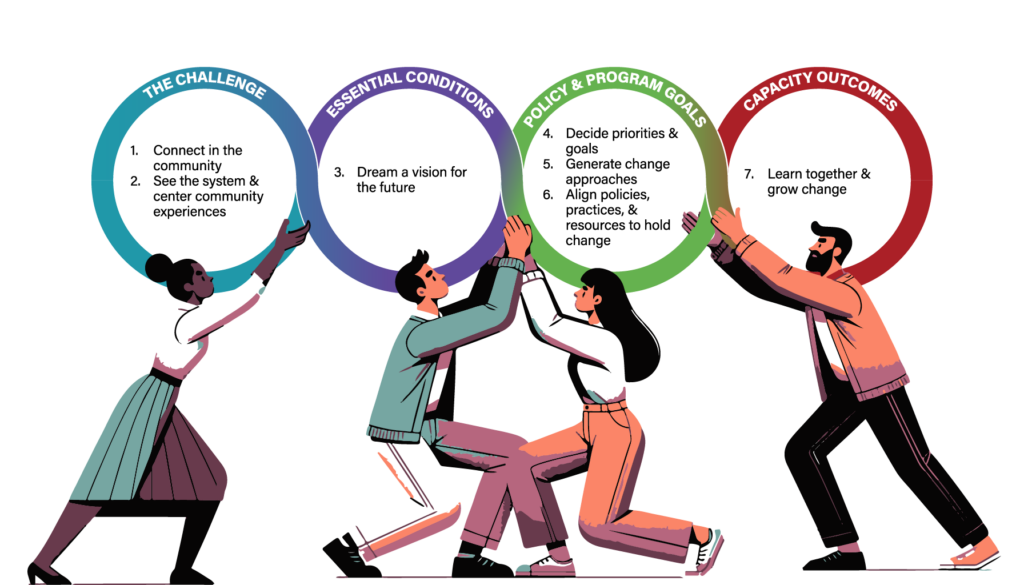Element 4: Decide Priorities and Goals
Once a community-defined vision has been established, work together to determine priorities and goals that align with the vision and that are rooted in an understanding of the system and the community’s experiences and aspirations. Priorities will help guide future investments, actions, and services, and goals will inform how the impact of systems-change efforts is measured.

Case Story:
Native American Community Academy
The Native American Community Academy (NACA) was founded in
Albuquerque, New Mexico, in 2006 as a response to local interest in a school that would deeply understand and serve the needs, strengths, and goals of its local Native American community. Led by former executive director Kara Bobroff and former head of school Anpao Duta Flying Earth, the NACA founding team organized listening sessions with over 200 people from the community to ensure that the school’s approach reflected the vision and priorities that community members had for public education—from instructional design to incorporating cultural and spiritual knowledge and traditions throughout the school day. Listen to this case story clip to hear more about how NACA engaged in expansive community outreach efforts to ensure school programming reflected the priorities of students, families, and other community members.
Reflection Pause
- How does your school or district partner with community members to make decisions about priorities and goals?
- How does your school or district determine which priority areas are most important to address? Do the priorities and goals seek to address root causes identified by the community? Will the priority areas move the community closer to the shared vision?
Interrelationship Diagram Activity
- Generate an equity challenge statement. What is an equity challenge you or your team need to solve? Express the challenge in one sentence.
- Brainstorm possible causes: Based on your own understanding of the equity challenge, brainstorm as many causes as you can that might be contributing to the challenge and categorize the causes (if you’ve already generated a fishbone diagram, use the categories of causes from the diagram).
- Create a Chart: Repeat until you have established a relationship between all issues.
- Reflect: Identify cause and effect relationships.: Draw a circle on a piece of paper or chart paper and list the categories of causes (or issues) around the circle. Review each cause and determine the relationship between that cause and each of the other causes on the paper. For each pair of causes, ask yourself:
- Is there a relationship between these two causes?
- If yes, which causes the other the most?
- Draw an arrow from one to the other to show directionality. You can decide there is no causal relationship, but you must pick a direction if you see a relationship. There should be no lines with arrows at both ends. Repeat until you have established a relationship between all issues.
- Narrow down root causes. Count the number of arrows going in and out for each cause. Causes with the most arrows leading out are likely to be root causes that are contributing most to your equity challenge.
- Reflect. Which root causes have you learned are at the heart of your equity challenge? What steps can you or your team do now to address the root causes of your challenge? Is there further analysis that might need to be done to better understand the root causes you’ve identified?
Resources to Explore
- Consensus Cased Decision Making Process: A process for building consensus and arriving at a final decision
- Decision-Making Norms: A list of agreements that can be used to help guide how community members engage with one another as they make decisions
Beyond SEL. WestEd. https://beyondsel.wested.org/audiocast/integrating-identity-affirmation-with-teaching-and-learning/
Interrelationship Digraph Protocol. This protocol has been from the protocol created by the High Tech High GSE Center for Research on Equity and Innovation.
Valdez, A., Cerna, R., & Hashmi, S. (2023). Participatory systems change for equity: An inquiry guide for child-, youth-, and family-serving agencies. California Center for School Climate & Center to Improve Social and Emotional Learning and School Safety. WestEd.

